Leroy Brownlow
1914-2002
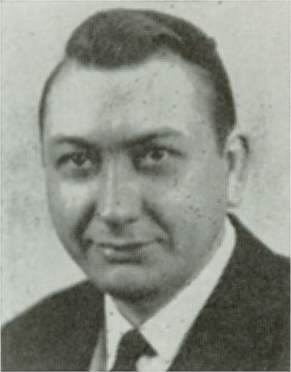
Leroy Brownlow
Preacher, Author, Writer, Publisher, Business Man
By Noble
Patterson
Christians in Fort Worth and throughout the nation were deeply saddened upon learning of the death of Leroy Brownlow, Nov. 8, 2002, at age 88. Memorial services were conducted at the Bridgewood Church of Christ, in Fort Worth on November 12, with Robert Bankes, Robert Bostick and Paul Brownlow officiating.
Brownlow had suffered a severe stroke in 1993 and was not expected to live. As a result of the stroke, for the last nine years of his life he was incapacitated and was cared for at Bishop Davies Nursing Home in the Fort Worth suburb of Hurst. His influential voice has been felt around the world through his preaching and writing.
Leroy was born April 30, 1914, on a farm in Cooke County near Callisburg east of Gainesville, Texas. He was the oldest of three children, the other two being girls. He attended school at Callisburg for a number of years and became a graduate of the high school at nearby Whitesboro, finishing his course with honors in 1931. Leroy did not grow up in the church. His parents were from different religious groups; his mother was a Presbyterian, and his father taught Sunday school in a Methodist church. His grandfather was a Baptist preacher for 65 years.
It was during this early period that Brother Paul C. Witt, of the Science Department at Abilene Christian College conducted a summer gospel meeting in Callisburg. The Brownlow family attended these services regularly. Leroy's parents would come home from the meeting and study their Bibles by light of a lantern until late night. They concluded that the concept of New Testament undenominational Christianity was a valid one. Leroy came to the same conclusion and during this meeting was baptized at age 17. That changed everything! Even though Leroy had already enrolled at Southern Methodist University to pursue an engineering degree, Brother Witt encouraged the talented young man to attend Abilene Christian College and become a preacher. Leroy abandoned his plans to go to Southern Methodist University, packed up his belongings and drove to Abilene with his friend and mentor, Paul C. Witt, and entered Abilene Christian College. Leroy changed his major to Bible and Greek and returned home to preach his first sermon in Callisburg during the Christmas holidays in 1931. His topic was "I Am Ready to Preach the Gospel." This expression from the pen of the apostle Paul seems to have been the expression of Leroy's life ... he was always "ready" to tell the sweet story. The church building was packed with old friends and acquaintances that had an interest in the welfare of the young gospel preacher.
After one year of college work, he taught in Texas public schools at Callisburg for two years and preached regularly on weekends for the Callisburg church. Throughout his years at Abilene Christian College he preached regularly each weekend and held meetings in the summer. During his sophomore year he preached regularly at Albany, Texas, and Putnam, Texas. In his junior and senior years he preached full time in Rochester, Texas. He was eighteen years of age when he held his first gospel meeting in Bartonsville, Texas, which lasted ten days. Years later Leroy reminisced and stated that the meeting could not have lasted longer or the sermons would have run out. Fourteen were baptized and two restored. There were also 14 baptisms in his second meeting and 15 in the third meeting. The year he was 20 he preached 65 consecutive days in open-air meetings that resulted in 66 baptisms. Outdoor audiences were amazed as nightly the boy preacher defied flying bugs and denominational hecklers to preach simple truths.
Leroy worked and paid all his college expenses, and this was in the midst of the Great Depression. He left Abilene Christian College as an honor graduate, with a new car paid for and a substantial bank account.
On Nov. 22, 1937 Leroy married Miss Ferne Amrein of Norman, Okla. She was also a student at Abilene Christian College having attended for one year. Later she received a Bachelor of Arts Degree from the University of Oklahoma. She died in 1994 in Fort Worth.
Leroy's interest and ability in business was apparent, as he was successful through the years in various secular pursuits including finance, investments, real estate, oil, and publishing. Leroy never preached for a paycheck; he preached because of conviction. Preaching the gospel always occupied first place in his life. As a result, he never made any money preaching, but God blessed his businesses to more than make up for the low salaries from the brethren. His endeavors, both spiritual and secular, were always crowned with success.
Upon graduation from Abilene Christian College in 1937, Leroy began the pivotal period that would produce his book, Why I Am a Member of the Church of Christ. He not only preached full time in local church work but also held many meetings in the summer. During the summer of 1941, Leroy held meetings all over Alabama with Marion Davis, of Fayette, Ala., as his song leader. Marion was greatly impressed at Leroy's power and conviction and encouraged him to write a book on the subject. During 1941-42, Leroy wrote most of Why I Am a Member of the Church of Christ while he preached in Ennis, Texas.
After moving to the Polytechnic congregation in Fort Worth in 1943, he began searching for a publisher. The Gospel Advocate Company, in Nashville, Tenn., offered him a modest sum for the copyright, but he decided he would personally publish the book. In 1945, 2000 copies of the book were printed. They sold out in a few months, and more were printed. Since then, more than one million copies have been sold worldwide. He was a writer of unusual ability and eventually wrote over 30 books. Leroy's interest in writing and self-publishing books eventually became Brownlow Publishing Company, which he started with his son, Paul, in 1974.
In addition to being an accomplished and original writer Leroy, as a gospel preacher, shares a place in the church attained by only a few. He preached in some of the greatest and most fruitful gospel meetings including the cooperative meeting of 27 congregations in Tulsa, Okla., which marked the opening of the Tulsa Civic Center and averaged 8,500 in attendance per night. There were 190 responses, including 83 baptisms. L.O. Sanderson directed the singing.
In San Angelo, Texas the Fair Grounds Center was filled to over flowing as Leroy preached the unsearchable riches of Christ in a very forceful manner. The meeting was reported to be the largest religious gathering in the history of the city.
At the 5th and Highland church in Abilene, during the time E.R. Harper was the preacher, Leroy conducted a great gospel meeting in which there were a record number of conversions. Some individuals who were at Highland at that time still recall the meeting with Leroy in sincere and genuine expressions of appreciation.
During the Freed-Hardeman University Lectures in February 1991, Leroy electrified the audience of 3,000 with a great message on "Preservation of the Faith." He began the lecture with the statement, "The church, is facing the greatest danger I've seen in my lifetime." His concern was what was happening within the church ... not from dangers from without.
Furthermore, he had a clear insight into all of the troubling problems of the brotherhood and could analyze with great accuracy those problems that troubled brethren and divided churches. Leroy was very disturbed by what was, and is, taking place in the church.
He had a complete and thorough knowledge of the Bible, and a deep appreciation and reverence for the truth of God.
This presentation would be incomplete if we omitted relating the phenomenal ministry of Leroy Brownlow and the amazing record that he established in local church work at the Polytechnic church in Fort Worth during the 22 years he preached there. Here was developed a conservative yet dynamic and aggressive church. The accomplishments stagger the imagination and represent a challenge to our concept of local church work.
The Polytechnic church had not always grown! In fact, prior to Brownlow's going there in 1943, it had increased only eleven members in ten years. The mighty works performed by the Polytechnic church were not due to their location. The building was on a dead-end street in a neighborhood that was not very attractive or affluent.
The aggressiveness of the Polytechnic church was not due to a large staff. There was only one preacher, one secretary and one custodian. In addition to doing the pulpit work, Leroy Brownlow was the chairman of the Sunday morning Bible classes and most of the time conducted the youth training programs, edited the church paper, directed the personal work and personally did much house to house, one-on-one teaching.
What led to this phenomenal growth? At the request of the elders, Brownlow preached in 40 percent of all the meetings, which averaged one every year. None lasted less than eight days; most of them went 15. As a result, the meetings in which he preached averaged 39 additions to the congregation per meeting ... most of them baptisms.
Under the
direction of Leroy Brownlow, the Polytechnic church developed a
highly successful youth program. Many of them became preachers,
including Andrew Connally, Doyle Gilliam, Bob Gilliam, Edwin Bills,
Webb Fry, Haun Kite, Randy McIntosh, Richard Clark, and Paul
Brownlow. At one time five, who grew up at Polytechnic under the
preaching of Leroy Brownlow, were serving as missionaries in
Africa. It is evident their youth program worked and was very
effective.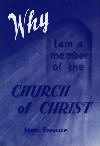
Concerning the Bible school, it was very effective in converting people, developing Christians and in molding a great church. Leroy believed that the courses should make the students strong and active members of the church, lovers of truth, and should prepare them to meet the issues of life. Accordingly, he never let the students get through high school without having the six-months study of Why I Am a Member of the Church of Christ and the six months study of Some Do's and Don't's for the Christian. No wonder so many became preachers and effective workers. Brownlow taught the auditorium class for several years, which had an attendance that ran from 300 to 400. He believed many non-members would attend a big class in an auditorium who would not attend a small class in a little room, because many feared being embarrassed or getting involved in an uncomfortable discussion. This class was the means of reaching many of the lost.
And what about the mission work? With Leroy's encouragement the Polytechnic church supported, without help from others, several preachers in various mission fields, supporting each missionary nearly as much as they did their own local preacher. Also, they built or bought church buildings in those areas. Some were in large cities like Minneapolis, St. Paul, and Milwaukee. Their missionaries, Harvey Childress and Guy Southern, pioneered the work in Minnesota.
The Polytechnic church, on a dead-end street, with a minimum staff became at one time the third largest church of Christ in the nation, and perhaps could have become the largest if it had chosen to do so rather than establish other congregations in the surrounding neighborhoods. Polytechnic gave 200 members, two elders, 16 teachers and assistant teachers to start the Meadowbrook congregation. The remarkable thing is the very next year under the preaching of Leroy Brownlow, Polytechnic had a higher average attendance than the year before! They gave 200 members to start Eastland Street. They helped to start Vickery Boulevard all over again after the former group moved to Mitchell Boulevard. They assisted in establishing Flamingo Road and Linwood congregations. Also, they bought and paid for the prime location and set aside $160,000 to start the Brentwood church, now Bridgewood.
Here was a congregation that was free of the selfish, competitive spirit, but rather was interested in the growth of all congregations and in the Lord's work everywhere. This is further evident in that Polytechnic took the lead in running the directory ad in the Fort Worth Star Telegram that included all the congregations, whether they contributed monetarily or not. Leroy believed it wise to advertise our strength and numbers. Furthermore, it was a gesture of helpfulness to give the smallest churches as much publicity as the largest ones. Consequently, Polytechnic withdrew its own weekly, private ad. Their unselfishness and strong commitment to help all congregations was truly a great Christian example.
Leroy and the Polytechnic elders led the church to be forceful in the defense of the gospel. When Dr. J. Frank Norris, pastor of the First Baptist Church in Fort Worth, which had the largest Sunday School in the world, began to broadcast daily on radio a challenge for the churches of Christ to send forth a man to meet him in debate, it was Leroy Brownlow and the Polytechnic church that took the lead in accepting his challenge and in silencing him on the matter. They chose Foy E. Wallace, Jr. to meet him, and Dr. Norris refused to meet Wallace.. he backed down (Perhaps Norris recalled the defeat he suffered in the Wallace-Norris debate in 1934). Nobody questioned the soundness of this church or their preacher. When the anti-cooperation movement came into the Fort Worth area, Brownlow and the Polytechnic church stood firmly on the ground we had occupied for years which was cooperation. Most of the preachers, at first, were influenced by it.
Under the leadership of Leroy Brownlow the Polytechnic church was very aggressive and set the good example and pattern in many areas.
For instance:
It was the first church in the area to have off-street parking.
The first church west of the Mississippi River to have a mail-out bulletin or paper.
The first church in the Fort Worth area to have a full-time secretary.
The first church of Christ in the world to be on television.
So far as I know, the first church to have busing. In 1944 they rented a bus with its driver from the Fort Worth Transit System and ran it for about six weeks and gave it up because the people did not want to ride it. They were ahead of the times.
It was the first church to have air-conditioning Brownlow stated that some of the preachers really nailed his hide to the barn door on this one saying it was a waste of money. But he took the position that if you could heat the air to make it comfortable, you could also cool it to make it comfortable. Later the critics accepted his logic.
It was the first church west of the Mississippi River to have the same preacher for as long as 2 years.
The Polytechnic Church of Christ, during the ministry of Leroy Brownlow, was conservative ... yet dynamic and aggressive. The good positive influence of Leroy Brownlow and the Polytechnic church will live on for generations yet to come.
As churches of Christ are now in the new centurn, the need to renew the spirit and plea of the Restoration is crucial. And in this day of many uncertain sounds, Leroy Brownlow was and is one of. those clear voices pointing the way and helping us get back to the basics of seeking and saving the lost. Leroy Brownlow deserves the gratitude of the brotherhood of the saved.
-Firm Foundation, Vol. 118, No. 7; July, 2003, Houston, Texas, by Nobel Patterson Farmers BranchFort Worth, TX 76108
![]()

Leroy Brownlow Signature
Courtesy of Terry J. Gardner, 04.2010
![]()
Directions To Grave
The grave of Leroy Brownlow is located in Colleyville, Texas between Gravevine and Ft. Worth. On Hwy 26 in Colleyville, heading east you will see the Blue Bonnett Hills Cemetery on your right. Enter at the eastern most entrance (closest to the mausoleums) and proceed into the cemetery. Go to the top of the hill and you will come to a large fountain. Make your way around the fountain and continue on to the top of the hill. At the top of the hill you will come to a cross road. Turn right and go until you see the Garden of Remembrance on the left. Note picture below to see the location of the grave. While in this graveyard, be sure to visit the graves of Thomas B. Warren, Avon Malone, & Will Slater, other great church leaders of the 20th century. He and his wife are buried in the mausoleum back down the hill at the entrance. Pull to the front of the mausoleum and go in. The Warrens are buried on the bottom, right hand side in the main corridor.GPS Coordinates
N32° 53' 623" x WO 97° 08' 486"
Garden Of Remembrance
Space 3 Lot 69
Accuracy To Within 14'
Facing East
See Map Here
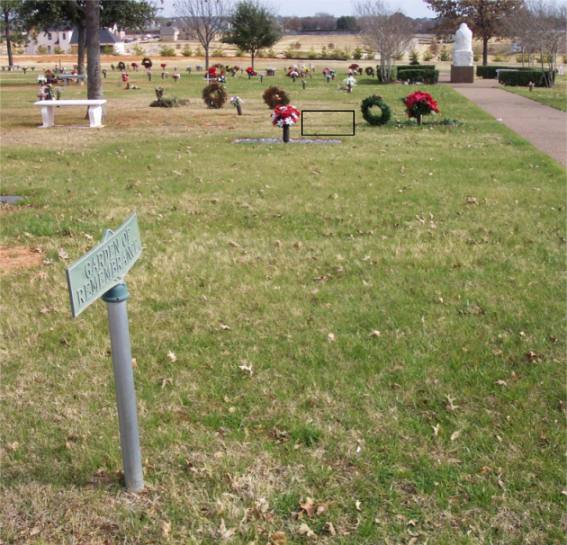
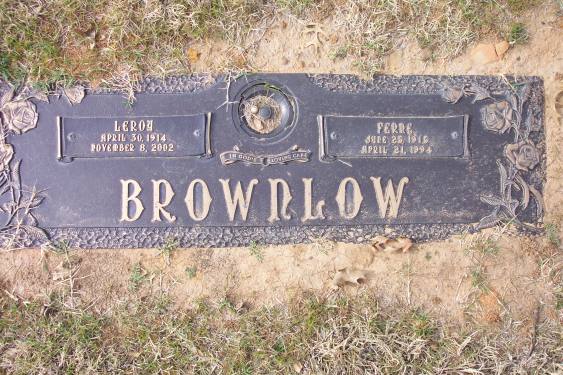
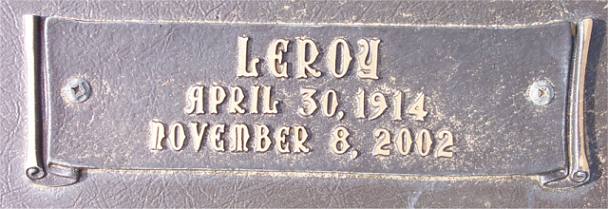
![]()